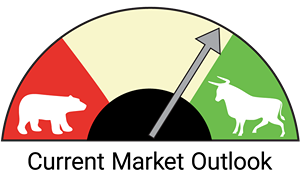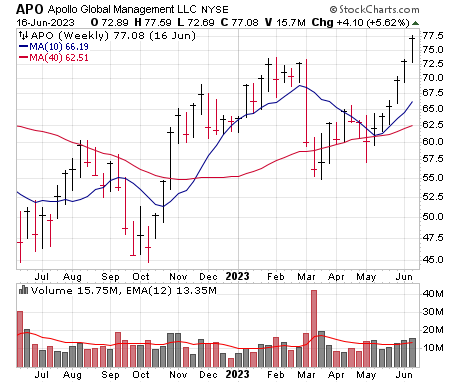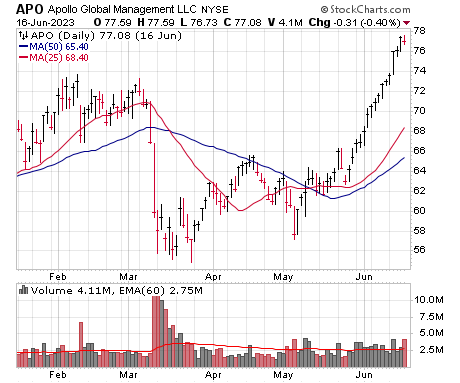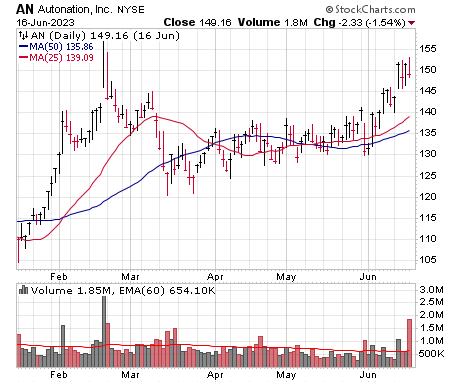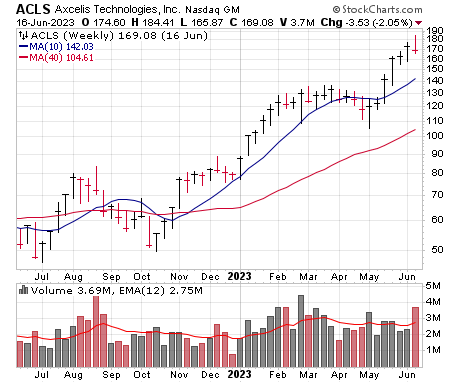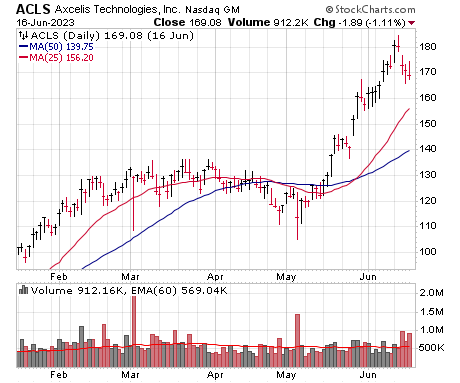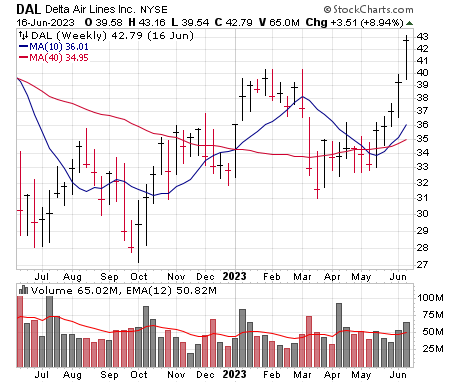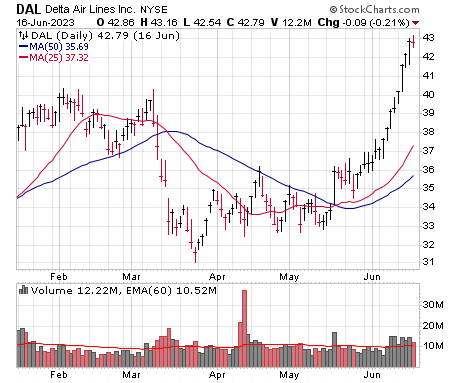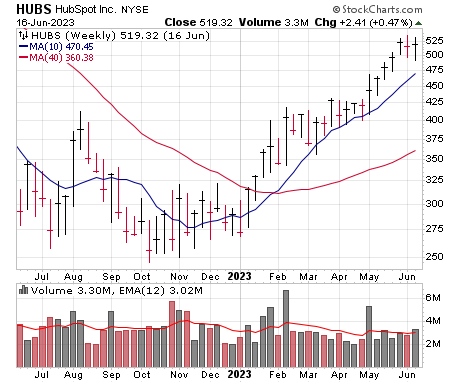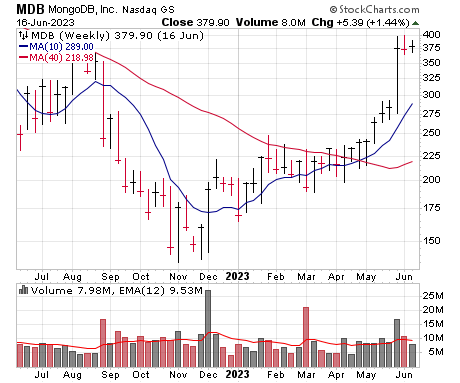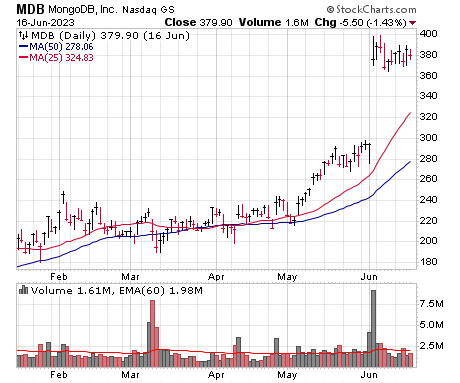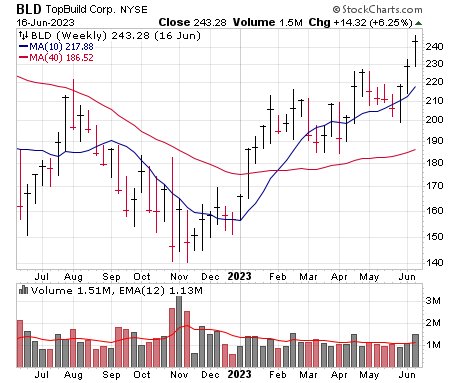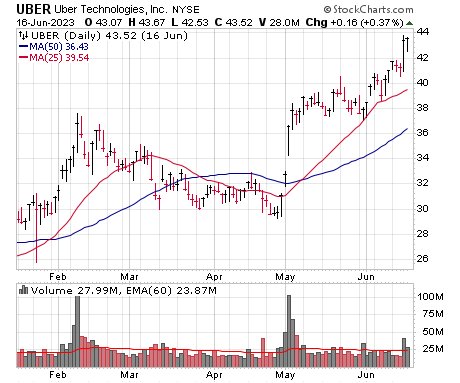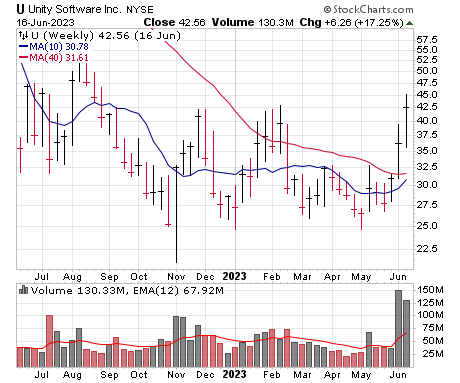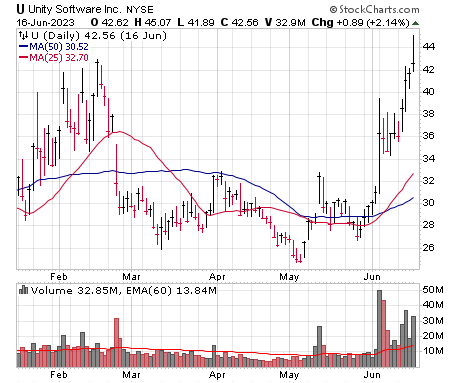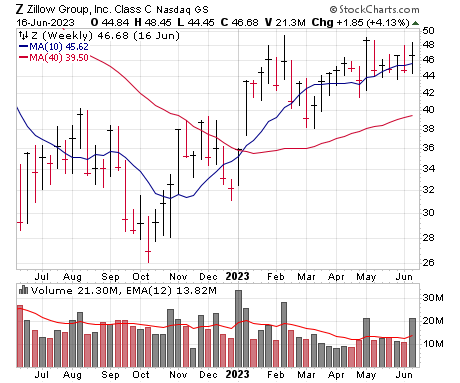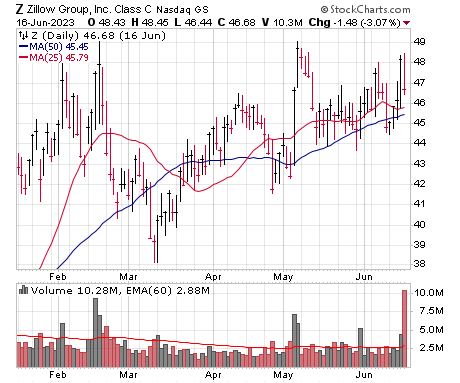Better and Better, though Short-Term Extended
The market has been in something of a takeoff or lockout rally, with pullbacks limited to a few hours or couple of days before buyers swoop in—longer term, the broadening of the rally, increased number of breakouts and the like bode well. Near term, though, we’re finally seeing some profit taking set in; coming into today, the Nasdaq was 9% above its 50-day line and many stocks were also in nosebleed territory, so some wobbles are to be expected and looking for dips when entering makes sense. Even so, we’re not really changing our advice any at this point—if the intermediate-term trend reverses or leaders flash abnormal action, we’ll certainly change our tune, but we like to play the odds, and right now the odds favor (a) near-term trickiness but also (b) that pullbacks should generally lead to higher prices. We’ll leave our Market Monitor at a level 7 and see how it goes.
While growth could be set for a dip, the broadening of the rally is seeing more non-growth names actually show strength. Our Top Pick is Delta Air (DAL), which is one of many cyclical-type stocks that, after a big hiccup in March with the banking worries, has come alive amidst a vacuum of selling pressure. Dips of a couple of points would be tempting.
Price |
| Apollo Global (APO) |
| AutoNation (AN) |
| Axcelis Technologie (ACLS) |
| Delta Air Lines (DAL) ★ Top Pick ★ |
| HubSpot (HUBS) |
| MongoDB (MDB) |
| TopBuild (BLD) |
| Uber (UBER) |
| Unity Software (U) |
| Zillow (Z) |
Stock 1
Apollo Global (APO)
Price |
Why the Strength
Apollo is one of the world’s largest alternative asset managers, specializing in private equity and real estate investments (its holdings include Yahoo, ADT and Shutterfly). What separates Apollo from its peers is that, thanks to a recent acquisition of life insurance company Athene, it’s one of the few asset managers that can deploy insurance funds into higher-return investments like private credit, earning the company a spread. (Apollo believes it can more than double fee-related earnings in the wake of the Athene merger between now and 2027.) The numbers in the table below are a bit jagged because of how Apollo accounts for things (investment losses crimp revenue, for instance), but there’s little doubt things are headed in the right direction: In Q1, total assets under management (AUM) leapt 17% to nearly $600 billion, including an 8% gain in fee-generating AUM (providing some reliability to the income stream) while fee- and spread-related earnings leapt 45% in the quarter. And, despite the tricky environment, Apollo continues to raise money, with $154 billion of inflows in the past year, and with a fundraising target of $130 billion for 2023 as a whole (up 25% from 2022), bolstered in part by improving inflows at Athene. Apollo is also focused on growing its international insurance business, with three “significant” reinsurance relationships recently made in Japan. Going forward, Apollo plans to use free cash flow for strategic growth investments, as well as capital returns via opportunistic buybacks and dividend increases (current yield of 2.2%). Even better is the market itself—if the bear phase in most asset values is drawing to a close, it obviously will bode well for asset managers like Apollo.
Technical Analysis
The last year hasn’t been the prettiest one on record for listed private equity firms, but APO has managed to outperform the industry. The low last October led to a solid rally, though the banking-induced hiccup in March was painful. But APO steadied itself from there, and the real eye-opener has been the recent action, with the stock acting like smoke up a chimney, rallying 15 days in a row (!) before hesitating. We’re OK starting small here or on dips of a point or two.
| Market Cap | $43.7B | EPS $ Annual (Dec) | ||
| Forward P/E | 12 | FY 2021 | 7.32 | |
| Current P/E | N/A | FY 2022 | 5.21 | |
| Annual Revenue | $15.4B | FY 2023e | 6.59 | |
| Profit Margin | 19.1% | FY 2024e | 7.81 | |
| Qtrly Rev | Qtrly Rev Growth | Qtrly EPS | Qtrly EPS Growth | |
| ($B) | (vs. yr-ago-qtr) | ($) | (vs. yr-ago-qtr) | |
| Latest qtr | 5.30 | 515% | 1.66 | N/A |
| One qtr ago | 4.84 | 305% | 1.06 | 16% |
| Two qtrs ago | 2.98 | 176% | -1.52 | N/A |
| Three qtrs ago | 2.27 | 64% | -3.53 | N/A |
Weekly Chart | Daily Chart |
Stock 2
AutoNation (AN)
Price |
Why the Strength
AutoNation is again set up to get moving for a few reasons, some general and some company-specific. First, the car dealership group, of which AutoNation is obviously one of the bigger players, continues to see good demand—while many expected sales and prices to fall off (both due to the end of pandemic-related supply chain issues and, this year, an expected recession), it turns out that demand is still pretty strong; in Q1, the firm saw gross profit per used vehicle sold rise 13% from a year ago, more than offsetting a volume decline. Second, AutoNation itself is not as reliant on sales of new and used cars as you’d think—after-sales revenue was up 9% in Q1 and made up 17% of the top line (and more of gross profit), with financial services (loans, etc.) making up another 5%. But the third and biggest factor is the firm’s continued, out-of-this-world share buyback program: The company’s share count at the end of March was down nearly 24% from a year ago and off a ridiculous 43% from two years before! Thus, when it comes to the business itself, things are retrenching somewhat—net income in Q1 was actually down 20% from a year ago—but on a per-share basis, earnings were up 5%, and analysts see the bottom line remaining north of $20 per share (!) both this year and next, even as business will likely slowly return to more normal activity and pricing levels. The end result is that the firm has tons of options with that cash—M&A, expansion and more, as well as healthy levels of share buybacks as the stock is trading at such cheap (6x to 7x earnings) valuations. There’s nothing revolutionary here, but profits remain elevated and the capital allocation decisions mean earnings should remain out of this world for a long time to come.
Technical Analysis
We wrote up AN in February after a huge earnings gap—it looked ready to go, but of course, the market didn’t cooperate and March’s banking issues caused the stock to fall back to its old highs. But shares steadied themselves from there, and after one more wiggle in late May, AN has ramped back up toward its old high. It’s not free and clear yet, but we think a small buy on dips and a plan to buy more on decisive strength makes sense.
| Market Cap | $6.80B | EPS $ Annual (Dec) | ||
| Forward P/E | 7 | FY 2021 | 18.14 | |
| Current P/E | 6 | FY 2022 | 24.58 | |
| Annual Revenue | $26.6B | FY 2023e | 22.45 | |
| Profit Margin | 4.5% | FY 2024e | 20.91 | |
| Qtrly Rev | Qtrly Rev Growth | Qtrly EPS | Qtrly EPS Growth | |
| ($B) | (vs. yr-ago-qtr) | ($) | (vs. yr-ago-qtr) | |
| Latest qtr | 6.40 | -5% | 6.05 | 5% |
| One qtr ago | 6.70 | 2% | 6.37 | 11% |
| Two qtrs ago | 6.67 | 4% | 6.00 | 17% |
| Three qtrs ago | 6.87 | -2% | 6.48 | 34% |
Weekly Chart | Daily Chart |
Stock 3
Axcelis Technologies (ACLS)
Price |
Why the Strength
Axcelis Technologies has been one of the leaders of the chip sector all year, breaking out way back on January 6 and remaining in good overall shape today. From a big-picture perspective, the story here is fairly simple: Axcelis’ Purion line of chip equipment is the top choice among a growing number of firms that are plowing into the silicon carbide (SiC) chip space—SiC chips operate more efficiently at higher temperatures and thus are perfectly suited for power-hungry applications, the biggest of which are various devices on electric vehicles. In the CEO’s own words on the latest conference call, “Axcelis is considered by power device customers to be the technology leader and supplier of choice, providing the best product family and manufacturer capabilities. This means that using Axcelis tools provides the lowest risk path to high volume manufacturing, required to support aggressive fab ramp plans.” To be fair, Axcelis’ SiC-related business is still ramping—the top brass expects 55% of systems revenue this year to be for power devices, and maybe half of that is SiC. That’s why revenues this year are expected to rise “only” 12%, though compared to a 20% or so downturn in the industry, that’s very good—and, of course, it positions Axcelis for better growth down the road. Analysts see earnings up about 20% this year and high-teens next, and the top brass thinks free cash flow can approach $10 per share within a few years if not sooner. All in all, the stock looks like the go-to play on the massive move to SiC chips, production of which should soar far into the late 2020s. We like it, albeit on pullbacks (see below).
Technical Analysis
As mentioned above, ACLS lifted to new all-time highs in early January and embarked on a great run, with sellers finally showing up for a couple of weeks pre- and post-earnings in April. But that dip was a brief shakeout, and the action after that was eye-opening, with a six-week boom to new highs near 180. Now ACLS is starting to pull in on some volume; we think the retreat is (a) likely to go farther, but (b) also likely to prove buyable. Dips toward the 25-day line would be something to target.
| Market Cap | $5.53B | EPS $ Annual (Dec) | ||
| Forward P/E | 26 | FY 2021 | 2.88 | |
| Current P/E | 30 | FY 2022 | 5.46 | |
| Annual Revenue | $970M | FY 2023e | 6.53 | |
| Profit Margin | 18.8% | FY 2024e | 7.59 | |
| Qtrly Rev | Qtrly Rev Growth | Qtrly EPS | Qtrly EPS Growth | |
| ($M) | (vs. yr-ago-qtr) | ($) | (vs. yr-ago-qtr) | |
| Latest qtr | 254 | 25% | 1.43 | 17% |
| One qtr ago | 266 | 29% | 1.71 | 63% |
| Two qtrs ago | 229 | 30% | 1.21 | 49% |
| Three qtrs ago | 221 | 50% | 1.32 | 140% |
Weekly Chart | Daily Chart |
Stock 4
Delta Air Lines (DAL) ★ Top Pick ★
Price |
Why the Strength
Airlines are seeing their earnings go bananas, but investor perception has been capped as many expected a recession to crimp business—but the longer that doesn’t happen, the more we’re seeing perception shift. Indeed, U.S. passenger plane bookings exceeded expectations over Memorial Day weekend, which marks the traditional start of the summer vacation season. Air travel topped pre-COVID levels, according to the Transportation Security Administration (TSA), with nearly 10 million passengers screened—3% more than the pre-pandemic 2019 travel period—and marking what is expected to be one of the best peak travel seasons in years. Combined with higher prices and limited supply, experts see global airline profits hitting $10 billion in 2023—more than 100% above earlier forecasts. Delta is America’s third-largest passenger carrier by capacity, and it’s one of the sector’s strongest stocks as business is going through the roof. Although per-share earnings of 25 cents missed estimates, revenue of nearly $13 billion jumped 36% from the year-ago quarter, while cargo and other revenue held up better than anticipated. The company said the business continues to “build momentum” and record advance bookings for the summer travel season prompted management to guide for record revenue in the June quarter—up to 17% higher. Delta also expressed confidence in its full-year guidance for up to 20% sales growth, earnings growth of over 70% and free cash flow of over $2 billion, while further reducing debt on its path to reach investment-grade credit metrics by 2024. Wall Street sees earnings north of $5 this year and $7 in 2024, and its possible even those will prove conservative as the economy remains resilient.
Technical Analysis
After bottoming last October, DAL rallied nicely to the 40 level, including showing some big-volume accumulation in January. The market wasn’t ready, though, and the sector got tossed around when economic fears resurfaced with the banking issues in March. But, impressively, the stock held firm near its 40-week line, and now the buying pressures are picking up steam, with DAL up five weeks in a row to 12-month highs. We’ll set our buy range lower, but we’re not expecting a huge retreat.
| Market Cap | $27.5B | EPS $ Annual (Dec) | ||
| Forward P/E | 8 | FY 2021 | -4.05 | |
| Current P/E | 9 | FY 2022 | 3.20 | |
| Annual Revenue | $54.0B | FY 2023e | 5.65 | |
| Profit Margin | 1.3% | FY 2024e | 7.01 | |
| Qtrly Rev | Qtrly Rev Growth | Qtrly EPS | Qtrly EPS Growth | |
| ($B) | (vs. yr-ago-qtr) | ($) | (vs. yr-ago-qtr) | |
| Latest qtr | 12.8 | 36% | 0.25 | N/A |
| One qtr ago | 13.4 | 42% | 1.48 | 573% |
| Two qtrs ago | 14.0 | 53% | 1.51 | 403% |
| Three qtrs ago | 13.8 | 94% | 1.44 | N/A |
Weekly Chart | Daily Chart |
Stock 5
HubSpot (HUBS)
Price |
Why the Strength
HubSpot, which provides marketing and customer relationship management software to small and mid-sized businesses, has made a successful transition to the software-as-a-service (Saas) model in recent years. Indeed, it’s now the world’s most popular CRM provider for smaller firms and continues to see its subscriber base expand while retaining existing clients. More recently, the company is making a foray into the artificial intelligence (AI) realm by adding AI tools, which it believes will boost demand for its platform. Earlier this year, HubSpot launched OpenAI-based Content Assistant, which allows clients to effortlessly create marketing e-mails, blog posts and landing pages. It also launched ChatSpot, a conversational bot that automates tasks using natural language queries—and which has had over 40,000 user signups since March—in a further step toward the company’s strategy of “ambitiously integrating” AI across its entire offering. In Q1, revenue grew nearly 30% from a year ago, led by a 27% leap in subscription sales and a 12% increase in services revenue, while per-share earnings of $1.20 beat estimates by 37 cents. The firm added almost 10,000 new clients in the quarter, bringing the total customer count to over 177,000 (up 23% year-on-year). Average subscription revenue per customer grew a bit (up 3%) thanks to continued multi-module adoption by HubSpot’s professional and enterprise customers (over 45% of its installed base is now on three or more modules). Gross retention, meanwhile, “remained healthy” in the high 80s percent and calculated billings (a leading indicator) grew 26% in Q1, to $533 million. Looking ahead, top-line growth should be solid (20%, maybe a bit more) while the bottom line is expected to roar ahead.
Technical Analysis
HUBS formed a deep bottoming base from last August to mid-February, and instead of correcting with the market during the bank panic, shares traded tightly and hugged their 10-week line for the next couple of months. The stock broke out on earnings seven weeks ago and had a nice run to 535 before hesitating the past couple of weeks. So far, the selling has been contained, with the 25-day line offering support. We’ll set the buy range down a smidge, with a stop under the rising 50-day line.
| Market Cap | $25.8B | EPS $ Annual (Dec) | ||
| Forward P/E | 107 | FY 2021 | 1.82 | |
| Current P/E | 151 | FY 2022 | 2.91 | |
| Annual Revenue | $1.84B | FY 2023e | 4.84 | |
| Profit Margin | 12.3% | FY 2024e | 6.06 | |
| Qtrly Rev | Qtrly Rev Growth | Qtrly EPS | Qtrly EPS Growth | |
| ($M) | (vs. yr-ago-qtr) | ($) | (vs. yr-ago-qtr) | |
| Latest qtr | 502 | 27% | 1.20 | 122% |
| One qtr ago | 470 | 27% | 1.11 | 91% |
| Two qtrs ago | 444 | 31% | 0.69 | 38% |
| Three qtrs ago | 422 | 36% | 0.44 | 2% |
Weekly Chart | Daily Chart |
Stock 6
MongoDB (MDB)
Price |
Why the Strength
MongoDB’s cutting-edge enterprise database software is seen as disrupting the existing competitive landscape through its cloud-based platform that appeals to large companies looking to construct systems that are faster and more flexible. In a nutshell, established database systems split up data sets for storage then reconstruct them when they need to be accessed, a process that maximizes what used to be costly storage space. MongoDB stores data sets whole, as objects, allowing for faster and more efficient retrieval in today’s low-cost storage world. Even with a lot of headwinds for corporate software (lengthening deal cycles as clients tighten the purse strings), MongoDB was able this month to raise its full-year 2024 guidance (ending next January), projecting nearly 19% sales growth to about $1.53 billion. Consensus now sees normalized EPS of $1.53 for the year, almost double 2023. Like most tech companies, MongoDB’s management sees benefits to come from AI but isn’t throwing lots of money at its own AI products. Instead, it reports its clients are utilizing its Atlas platform, which generates two-thirds of revenue, as their base on which to develop their own generative AI features. That fits with MongoDB’s general approach, where it aims to expand business by increasing how existing customers use its systems. At the entry level, that means MongoDB adopts a “freemium” business model, with an entry-level service that’s free followed by paid subscription and service tiers. There’s plenty of growth to be had: MongoDB has just 2% market share of the $80 billion annual database market, a portion that should rise as cloud-based systems increasingly become the choice for corporations.
Technical Analysis
MDB plunged from nearly 600 in late 2021 to a low under 140 last November, but the turnaround started in December when shares gapped up on their heaviest-ever weekly volume after earnings. Shares consolidated mostly under the 40-week line from February to early May, but MDB broke out May 10, rallied some and then exploded higher on earnings earlier this month—and the tight action since then is a good sign. It’s not for the faint of heart, but we’ll OK nibbling here or (preferably) after some weakness.
| Market Cap | $26.8B | EPS $ Annual (Jan) | ||
| Forward P/E | 248 | FY 2022 | -0.02 | |
| Current P/E | 341 | FY 2023 | 0.81 | |
| Annual Revenue | $1.37B | FY 2024e | 1.54 | |
| Profit Margin | 12.3% | FY 2025e | 2.32 | |
| Qtrly Rev | Qtrly Rev Growth | Qtrly EPS | Qtrly EPS Growth | |
| ($M) | (vs. yr-ago-qtr) | ($) | (vs. yr-ago-qtr) | |
| Latest qtr | 368 | 29% | 0.56 | 180% |
| One qtr ago | 361 | 36% | 0.57 | 375% |
| Two qtrs ago | 334 | 47% | 0.23 | 667% |
| Three qtrs ago | 304 | 53% | -0.23 | N/A |
Weekly Chart | Daily Chart |
Stock 7
TopBuild (BLD)
Price |
Why the Strength
TopBuild (covered in the March 6 issue) is a leading distributor of thermal insulation and related building materials for the North American residential, commercial and industrial markets. Despite continued weakness on the residential side of things, commercial building activity remains strong across many regions of the U.S. and contributed to solid top line growth and margin expansion for both of TopBuild’s main end markets (installation and specialty distribution). In Q1, revenue of nearly $1.3 billion exceeded the year-ago total by 8% and EPS of $4.36 beat estimates by 35 cents. Although nationwide housing starts were down in Q1 from a year ago, TopBuild’s installation segment was boosted by a large backlog of single and multifamily homes under construction, with the company reporting “improvements in terms of buyer interest” and it sees strong long-term housing fundamentals thanks to a limited supply of new and existing homes. The installation business is also benefiting from an increase in light commercial work, while the firm’s heavy commercial branches are also involved in several major projects, including the Salt Lake City Airport expansion, the new Microsoft and YouTube corporate centers and a new Intuit Dome (future home of the LA Clippers). On the specialty distribution front, TopBuild is serving a number of major industrial manufacturing projects, including the Tesla Gigafactory in Texas and a Taiwan Semiconductor manufacturing center in Arizona, as well as alternative fuel facilities for Marathon and Phillips 66. Like a lot of construction names, most investors expected earnings to come back down to Earth, but instead, TopBuild’s bottom line is expected to remain in the stratosphere and there are even signs residential housing is turning up.
Technical Analysis
BLD took a hit in 2022, when rising rates took a bite out of the residential market and investor perception soured; shares tumbled 50% between January and November. But as business has stayed resilient, the stock has been coming back, with a spike to 213 by the end of January, and then a choppy up-and-down phase with no net progress into late May. And now BLD is breaking out, with a strong move to 16-month highs. Minor weakness would be tempting.
| Market Cap | $7.74B | EPS $ Annual (Dec) | ||
| Forward P/E | 15 | FY 2021 | 10.85 | |
| Current P/E | 14 | FY 2022 | 17.11 | |
| Annual Revenue | $5.1B | FY 2023e | 16.21 | |
| Profit Margin | 10.9% | FY 2024e | 17.04 | |
| Qtrly Rev | Qtrly Rev Growth | Qtrly EPS | Qtrly EPS Growth | |
| ($B) | (vs. yr-ago-qtr) | ($) | 64 | |
| Latest qtr | 1.27 | 8% | 4.36 | 25% |
| One qtr ago | 1.26 | 19% | 4.40 | 41% |
| Two qtrs ago | 1.30 | 54% | 4.80 | 63% |
| Three qtrs ago | 1.27 | 53% | 4.43 | 61% |
Weekly Chart | Daily Chart |
Stock 8
Uber (UBER)
Price |
Why the Strength
Most of the firms that come public later in a bull market are crushed in the ensuing bear, but what’s also common is that the cream of that crop—those that continue to grow and are posting real profits and cash flow—will often enjoy a sustained run during the next bull move. That’s what we see playing out with Uber, which has kicked its main competition to the curb in ridesharing (Lyft continues to struggle; fears of intense competition are fading) and is a big player in delivery as well (mostly food, but expanding into groceries and other areas); indeed, both of these segments bring in nearly the same amount of bookings these days, with ridesharing growing nicely, up 43% in Q1 on a currency-neutral basis, and delivery up 12%. More important is that the land grab phase is over, as are all sorts of weird investments, with the top brass focused on the bottom line—EBITDA has been kiting higher every quarter for more than a year, coming in at $761 million in Q1, up many-fold from a year ago, yet still just 2.4% of overall bookings, which leaves plenty of room for growth. (Moreover, while earnings were in the red, free cash flow was $549 million, or about 27 cents per share.) Throw in the resilient economy, which should be good for the ridesharing business (more workers and more travel, etc.), and big investors are thinking management’s bullish outlook ($5 billion in EBITDA in 2024) will be hit, if not exceeded—and it doesn’t hurt that Uber is thinking about either selling or spinning off its freight business, which could bring in a good chunk of money (the operation had $1.8 billion of bookings in Q1 alone) that could be used to buy back shares, pay down debt and more. Of course, it’s not as sexy as the latest AI story, but there’s no reason Uber can’t spin off tons of cash in the years ahead.
Technical Analysis
It’s looking like UBER’s third attempt at getting going is the charm. The stock’s first attempt (and what initially caught our eye) was back in August, and after months of bottoming, the January/early-February ramp was very impressive. But after a calmer, more controlled base-building effort, the stock’s early-May ramp looks like the real deal, with five straight big-volume buying days before and after earnings, a sideways move (and tap of the 25-day line) for four weeks and now a push to higher highs. Like many names, we’re looking for minor weakness near term, but aren’t expecting a huge retrenchment.
| Market Cap | $88.1B | EPS $ Annual (Dec) | ||
| Forward P/E | 66 | FY 2021 | -0.26 | |
| Current P/E | N/A | FY 2022 | -4.66 | |
| Annual Revenue | $33.8B | FY 2023e | 0.66 | |
| Profit Margin | N/A | FY 2024e | 1.44 | |
| Qtrly Rev | Qtrly Rev Growth | Qtrly EPS | Qtrly EPS Growth | |
| ($B) | (vs. yr-ago-qtr) | ($) | (vs. yr-ago-qtr) | |
| Latest qtr | 8.82 | 29% | -0.08 | N/A |
| One qtr ago | 8.61 | 49% | 0.29 | N/A |
| Two qtrs ago | 8.34 | 72% | -0.61 | N/A |
| Three qtrs ago | 8.07 | 105% | -1.32 | N/A |
Weekly Chart | Daily Chart |
Stock 9
Unity Software (U)
Price |
Why the Strength
Apple says it is using Unity’s development tools on its new Vision Pro headset, adding momentum on top of strong earnings and outlook for the business. Unity is a platform used by video game makers to create games and utilized by industrial designers to improve factories and products. In what’s been a soft period for the game industry, Unity beat expectations for the first quarter, posting $500 million in revenue, a 56% jump, and $32 million in EBITDA, which was well above its guidance of around $10 million and up from a big loss a year ago. The performance showed that Unity has real pricing power, with the company able to push through recent rate hikes with no effect on its customer base. AI promises to make the company’s Create platform easier for programmers to use to build video games as well as ensure that nuances of gameplay result in unique renderings that may never appear again, based on the exact timing when players press a button. Like ChatGPT, AI will also provide for non-player characters that interact in the games more like real people. On the industrial side, for what Unity calls its Grow, AI will improve its digital twins, tech-based models of real-life machinery which companies use for predictive maintenance and process improvements—importantly, the digital twin side of the business can potentially be much larger than game design. Right now, the company is projecting Q2 will see sales of around $515 million, which would be up about 74% from 2022 with profitability up roughly 50%. For 2023, revenue of $2.1 billion is projected. Much of the year-on-year gains are from acquisitions, but the core business is still growing at solid double-digit rates.
Technical Analysis
Apple’s disclosure that it’s using Unity at its early June developer conference rocketed shares on massive volume through multiple points of resistance around the 200-day line. This came after months of super-volatile bottoming action from last November, too, which provides a firmer foundation for the move. Today’s dip was sharp but not out of character given the recent move; a bit more weakness should provide an opportunity to nibble.
| Market Cap | $16.1B | EPS $ Annual (Dec) | ||
| Forward P/E | 118 | FY 2021 | -0.18 | |
| Current P/E | N/A | FY 2022 | -1.16 | |
| Annual Revenue | $1.57B | FY 2023e | 0.36 | |
| Profit Margin | N/A | FY 2024e | 0.89 | |
| Qtrly Rev | Qtrly Rev Growth | Qtrly EPS | Qtrly EPS Growth | |
| ($M) | (vs. yr-ago-qtr) | ($) | (vs. yr-ago-qtr) | |
| Latest qtr | 500 | 56% | -0.67 | N/A |
| One qtr ago | 451 | 43% | -0.82 | N/A |
| Two qtrs ago | 323 | 13% | -0.14 | N/A |
| Three qtrs ago | 297 | 9% | -0.18 | N/A |
Weekly Chart | Daily Chart |
Stock 10
Zillow (Z)
Price |
Why the Strength
Zillow (covered in the May 8 issue) is the world’s leading online real estate marketplace of for-sale and rental listings. Most of Zillow’s business is derived from advertising fees paid by real estate agents, though it’s also expanding into providing mortgage lending in an ongoing effort at becoming a one-stop shop for house hunters. Although companies are rapidly jumping onto the artificial intelligence (AI) bandwagon, Zillow has been investing in AI for over a decade, starting with its free home value estimate tool, Zestimate, with plans to “harness [AI’s] power to drive growth.” On that score, the company has rolled out a plugin to power real estate searches on ChatGPT, along with making “significant investments” in improving its customer funnel, capturing more customer eyeballs and connecting them to its growing partner network, resulting in increased conversion rates in Zillow’s core Premier Agent business. Another big focus for Zillow going forward is the Housing Super App vision, an integrated, end-to-end platform based on the five pillars of 3-D virtual touring, financing, seller solutions, an enhanced partner network and integrating its services. Of course, none of this is going to outweigh the general environment: The soft housing market contributed to Zillow’s residential segment revenue dropping 14% in Q1, yet it still outpaced the 27% decline in the broad real estate market—a positive trend it sees continuing in Q2. Rental sales, moreover, exceeded expectations and rose 21% for the quarter, as prospective homebuyers turned to rentals while waiting for mortgage rates and prices to come down. Wall Street sees the bottom line slumping this year, but as the industry turns up and its initiatives take root, earnings are expected to reach new highs in 2024.
Technical Analysis
Z never hit our recommended buy range from our write-up in early May—we were looking for a strong breakout, but instead, the sellers pulled it back down. However, shares did hold their 50-day line and are trying to make another run at it; all together, the stock has set up a nearly five-month-long consolidation after some big accumulation earlier this year. We’ll again set our buy range up from here, thinking a decisive show of strength could lead to a sustained move.
| Market Cap | $11.0B | EPS $ Annual (Dec) | ||
| Forward P/E | 37 | FY 2021 | 1.58 | |
| Current P/E | 36 | FY 2022 | 1.43 | |
| Annual Revenue | $1.89B | FY 2023e | 1.27 | |
| Profit Margin | 18.6% | FY 2024e | 1.90 | |
| Qtrly Rev | Qtrly Rev Growth | Qtrly EPS | Qtrly EPS Growth | |
| ($M) | (vs. yr-ago-qtr) | ($) | (vs. yr-ago-qtr) | |
| Latest qtr | 469 | -13% | 0.35 | -20% |
| One qtr ago | 435 | -19% | 0.21 | -38% |
| Two qtrs ago | 483 | -12% | 0.38 | 0% |
| Three qtrs ago | 504 | -4% | 0.41 | -5% |
Weekly Chart | Daily Chart |
Previously Recommended Stocks
| Date | Stock | Symbol | Top Pick | Original Buy Range | 6/20/23 |
| HOLD | |||||
| 6/5/23 | 115.5-119.5 | 119 | |||
| 6/12/23 | Apellis Pharm | APLS | 88.5-91.5 | 88 | |
| 6/5/23 | 214-218 | 212 | |||
| 4/3/23 | 86-88 | 127 | |||
| 6/12/23 | Cameco | CCJ | 30.5-32 | 32 | |
| 5/15/23 | ★ | 123-128 | 141 | ||
| 5/30/23 | 68.5-70.5 | 73 | |||
| 6/12/23 | DoubleVerify | DV | 34.5-36.5 | 38 | |
| 3/13/23 | 17.3-18.0 | 25 | |||
| 3/6/23 | ★ | 115-121 | 150 | ||
| 5/22/23 | 160-165 | 172 | |||
| 5/15/23 | 76-79 | 94 | |||
| 5/1/23 | 34.5-35.5 | 37 | |||
| 5/1/23 | 52-54 | 60 | |||
| 3/20/23 | 378-388 | 516 | |||
| 4/24/23 | 262-270 | 313 | |||
| 4/24/23 | 58.5-60.5 | 65 | |||
| 6/12/23 | KBR Inc. | KBR | 62-64 | 65 | |
| 5/22/23 | 570-590 | 614 | |||
| 5/22/23 | 28-29.5 | 34 | |||
| 6/5/23 | 368-375 | 383 | |||
| 5/8/23 | 388-398 | 430 | |||
| 6/5/23 | 103-106 | 110 | |||
| 5/22/23 | Monday.com | 146-153 | 175 | ||
| 5/15/23 | 37-38.5 | 6762 | |||
| 2/27/23 | 225-230 | 438 | |||
| 6/5/23 | ★ | 221-226 | 242 | ||
| 1/9/23 | ★ | 218-226 | 338 | ||
| 4/17/23 | 47-48.5 | 60 | |||
| 5/30/23 | ★ | 525-540 | 559 | ||
| 5/8/23 | ★ | 63-65 | 74 | ||
| 11/21/22 | 44-46 | 63 | |||
| 6/12/23 | Shockwave Medical | SWAV | 284-294 | 300 | |
| 6/12/23 | Shopify | SHOP | 61.5-63.5 | 64 | |
| 3/27/23 | 124-128 | 157 | |||
| 5/22/23 | 131-135 | 139 | |||
| 5/30/23 | 65-66.5 | 75 | |||
| 6/5/23 | 70-73 | 76 | |||
| 5/8/23 | 37-39 | 42 | |||
| 5/30/23 | 31-32.5 | 32 | |||
| 6/12/23 | Vulcan Materials | VMC | ★ | 203-207.5 | 209 |
| 8/22/22 | Wingstop | WING | 115-120 | 190 | |
| WAIT | |||||
| 6/12/23 | Procore Tech | PCOR | 62.5-65 | 66 | |
| SELL RECOMMENDATIONS | |||||
| 5/30/23 | 713-733 | 720 | |||
| 5/15/23 | 306-313 | 294 | |||
| 4/24/23 | 285-295 | 328 | |||
| 6/5/23 | 41-43 | 37 | |||
| 6/12/23 | 284-294 | 300 | |||
| 6/5/23 | 174-179 | 179 | |||
| 5/30/23 | 47-49.5 | 53 | |||
| 5/30/23 | Workday | WDAY | 204-208 | 224 | |
| DROPPED | |||||
| 6/5/23 | 29.5-31 | 36 | |||
| 6/5/23 | 24.5-26 | 28 | |||
The next Cabot Top Ten Trader issue will be published on June 26, 2023.

